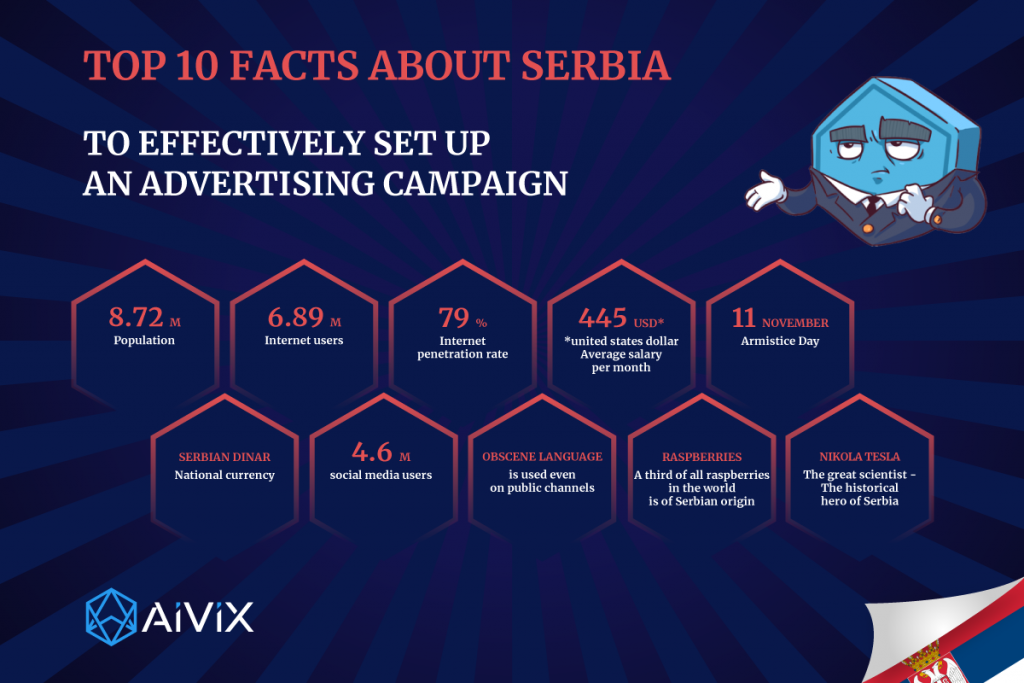
Geography and population of Serbia
Serbia is located in the southern region of Europe and borders many other European countries. The capital of Serbia is Belgrade, which is also Serbia’s largest city. In terms of area, Serbia is 111th in the world, with an area of nearly 30,000 square miles.
General information about Serbia:
– Capital city: Belgrade
– Area: 88,499 km²
– Phone Code: +381
– Top level domain: .rs /.srb
– Population: 6,926,705
The geography of Serbia is similar to the eight neighboring European countries. Both valleys and mountains can be found throughout the country (although Serbia is more mountainous than its neighbors). The main mountain range is the Balkan Mountains, which appears as a natural barrier between Romania and Bulgaria. Serbia’s highest point is Mount Deravigo, which is 700 feet high.
Due to the mountainous nature of much of the country, there are few natural lakes in the country. Most natural lakes are in Voevodino – an autonomous province located in the northernmost part of Serbia.
The climate of Serbia is divided into northern and southern. In the north, summers are usually very humid and hot and winters are cold, while in the south summers are hot and very dry, and winters are not only cold but also snowy.
Population of Serbia
Serbia has a population of about 7 million people, making it the 104th most populous country in the world. As in other European countries, the population is largely homogeneous: nearly 90% of citizens identify themselves as Serbs, with a small number of different ethnic groups, including Hungarians, Roma, and Bosniaks.
Major cities in Serbia:
– Belgrade (the capital): 1,154,589
– Novi Sad: 250,439
– Pristina: 198,112
– Nish: 183,164
– Kragujevac: 150,835
Since the 1990s, the population of Serbia has been gradually decreasing. In 1995, the population was 9.88 million, and in 2020 it is 8.8 million. Current projections indicate that the population will halve to 4.28 million by the end of the century.
Official language
Serbian is the official language of Serbia. It is considered the native language for about 88% of the population. In addition, it is the only European language that uses two different scripts. Serbian can be written in both Latin and Cyrillic alphabets.
The Serbian constitution recognizes the Serbian Cyrillic as the country’s official script and the Latin as the “script in official use.” According to a national poll, 47% of the Serbian population prefers using the Latin Serbian script, while 36% support the use of the Cyrillic alphabet. 17% – did not prefer either option.
Serbian is spoken throughout the country, with the exception of a few localities. There are also several dialects of the Serbian language. Torlak dialect is spoken by most Serbs in southern Serbia.
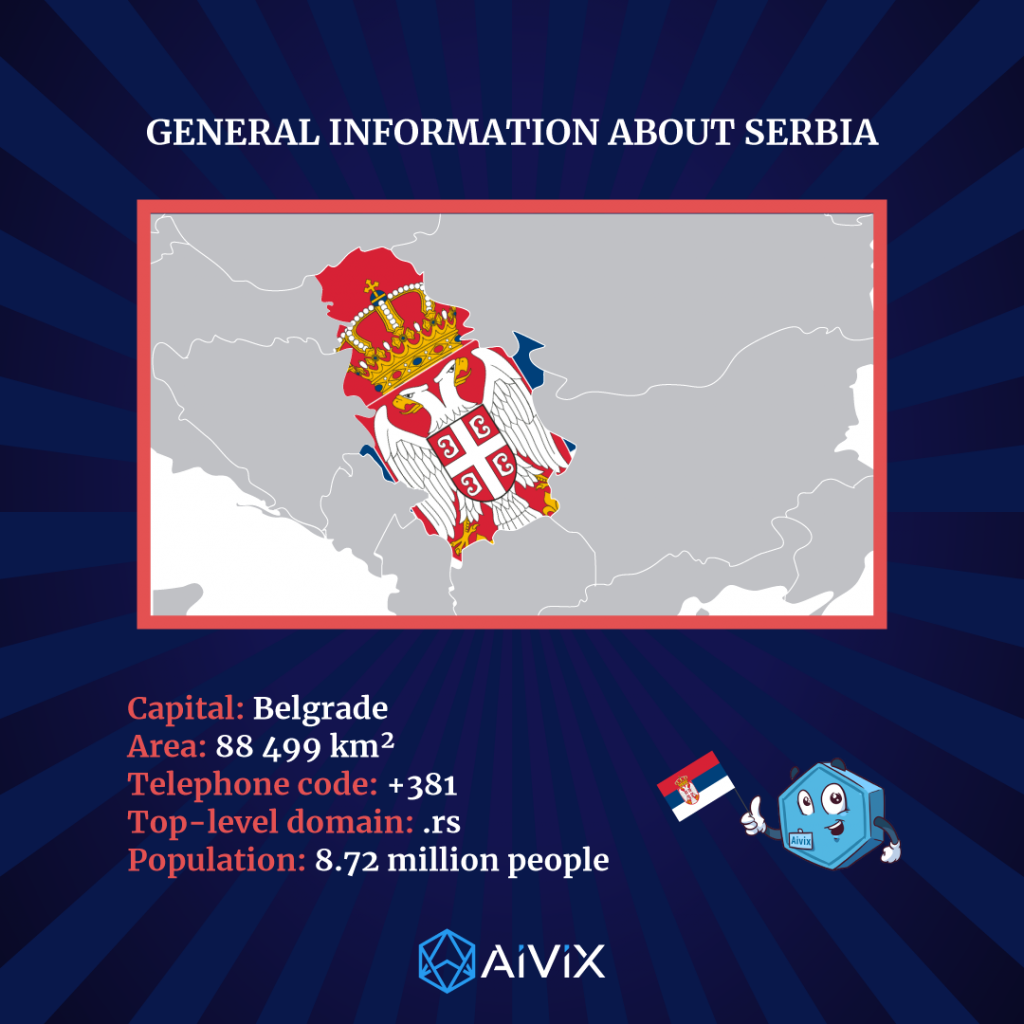
Currency in Serbia
RSD (Serbian dinar) is the official currency of Serbia. One dinar is divided into 100 pairs. This currency is used by approximately 6,908,224 people. According to our estimates, the Serbian dinar ranks 89th among the currencies in the world.
However, due to the low value of the currency, these coins were withdrawn from circulation back in 2008. At present, the citizens of Serbia use coins in denominations of 1, 2, 5, 10 and 20 dinars. However, 10-dinar coins are rarely used, as banknotes of the same denomination are more popular.
Internet in Serbia
Internet in Serbia is well used. In January 2021, there will be 6.89 million internet users in Serbia. Between 2020 and 2021, the number of Internet users in Serbia increased by 321 thousand (+4.9%).
The percentage of computers varies by territory: about 91% of families in Belgrade have a computer. The use of Internet services in Serbia is much higher than the EU average, but Serbian businesses have been relatively slow to integrate digital technologies. For companies with more than 250 employees, the use of cloud technology is still low, at 40%.
Residents in Serbia are actively using social media. Social media statistics in the country:
– In January 2021, there were 4.60 million social media users in Serbia.
– The number of social media users in Serbia increased by 350 thousand (+8.1%) between 2020 and 2021.
– In January 2021 the number of users of social networks in Serbia was 52.8% of the total population.
The Internet in Serbia remains relatively open, characterized by high levels of Internet accessibility, low levels of website blocking and strong constitutional protection for journalists. However, despite the diversity of online media, there has been an increase in misinformation spread by pro-government news sites, some of whose owners are affiliated with the ruling party.
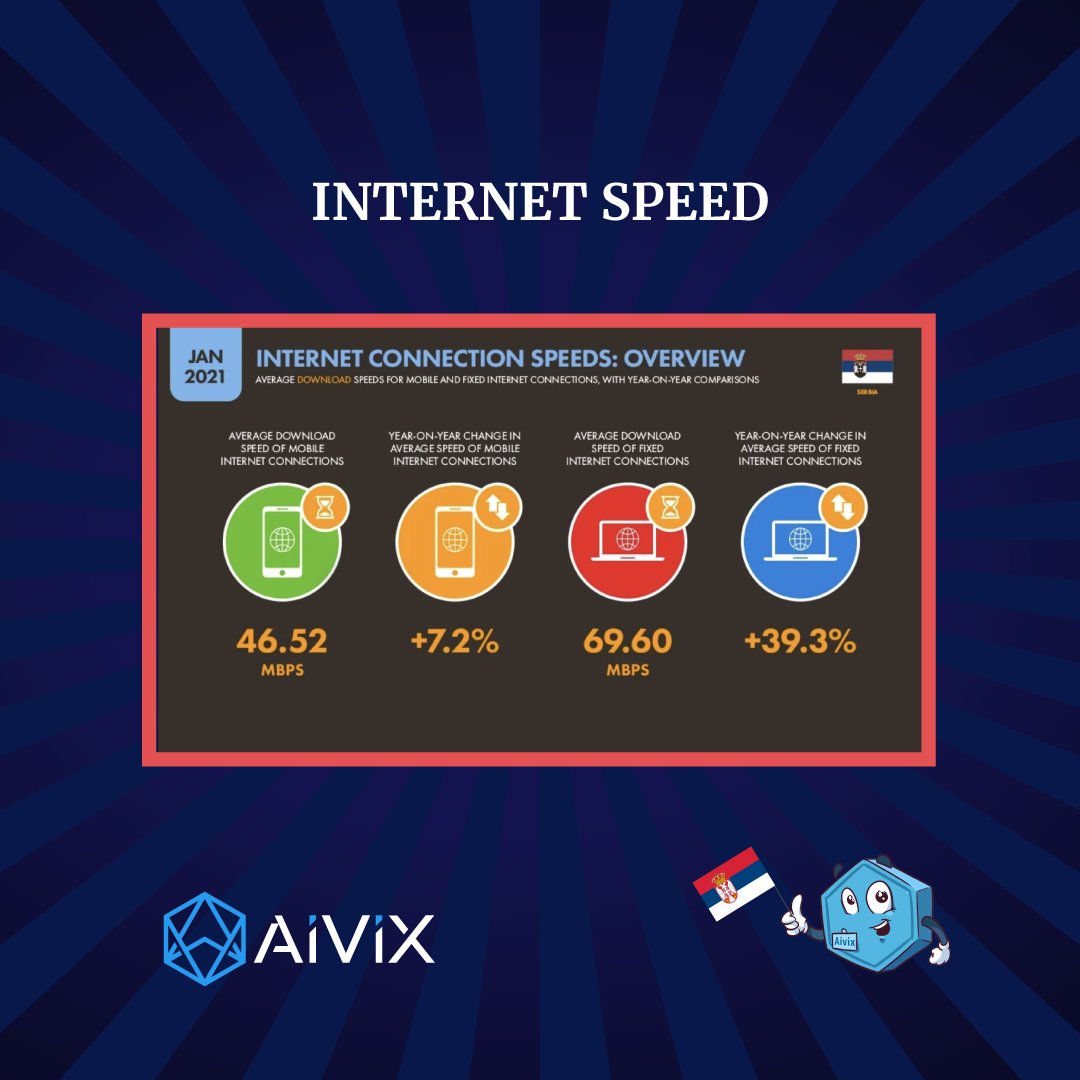
Economic development
The economy is not as well developed as in most European countries, but since the country joined the EU, there have been significant improvements. Serbia is a country with an economy in transition, dominated mainly by market mechanisms, but in some area there is still a significant influence of the public sector. The economy relies on production and exports, mainly due to foreign investments.
Average annual GDP growth increased from just +0.7% in 2010-2014 to +3.2% in 2015-2019. In 2020-2021, Serbia’s economy was less affected by the global pandemic than most other countries: GDP declined by a relatively modest -0.9%, while the overall decline in the region was -2.6%.
In 2022, the country is expected to see a strong economic recovery, driven by strong consumer spending, rapid growth in fixed asset investment, and a rapid increase in exports, while import growth will be more moderate. Experts forecast annual real GDP growth of about +5% in 2022.
The National Bank of Serbia aims to keep consumer price growth in the range of 3% in 2022-2023. Improved monetary policy did lead to low inflation from 2014 until mid-2021, as well as exchange rate stability since 2016. This allowed the NBS to steadily lower the key interest rate to 2.25% at the end of 2019 and then to 1.0% at the end of 2020 to support the economy after Covid-19.
Job in Serbia
The average wage in Serbia is now $1,961 per month or $23,537 per year. Wages are up 3% from $1,894.63 in 2018. The economy is expected to grow steadily and continuously in the coming years. However, taxes are very high in Serbia, so the average net after-tax salary is only $445 per month.
Average salaries by profession:
Nurse – $1450
Teacher – $1396
Waiter – $1145
Electrical Engineer – $1872
Dentist – $4318
Administrator – $1066
Police officer – $1490
Programmer – $1570
Although the unemployment rate is 9.50%, youth unemployment is as high as 24.40%. Many young people are unemployed, demonstrating the inability of the secondary education system to adapt to the needs of the labor market. Most unemployed youth have outdated skills, making it difficult to find employment in today’s marketplace.
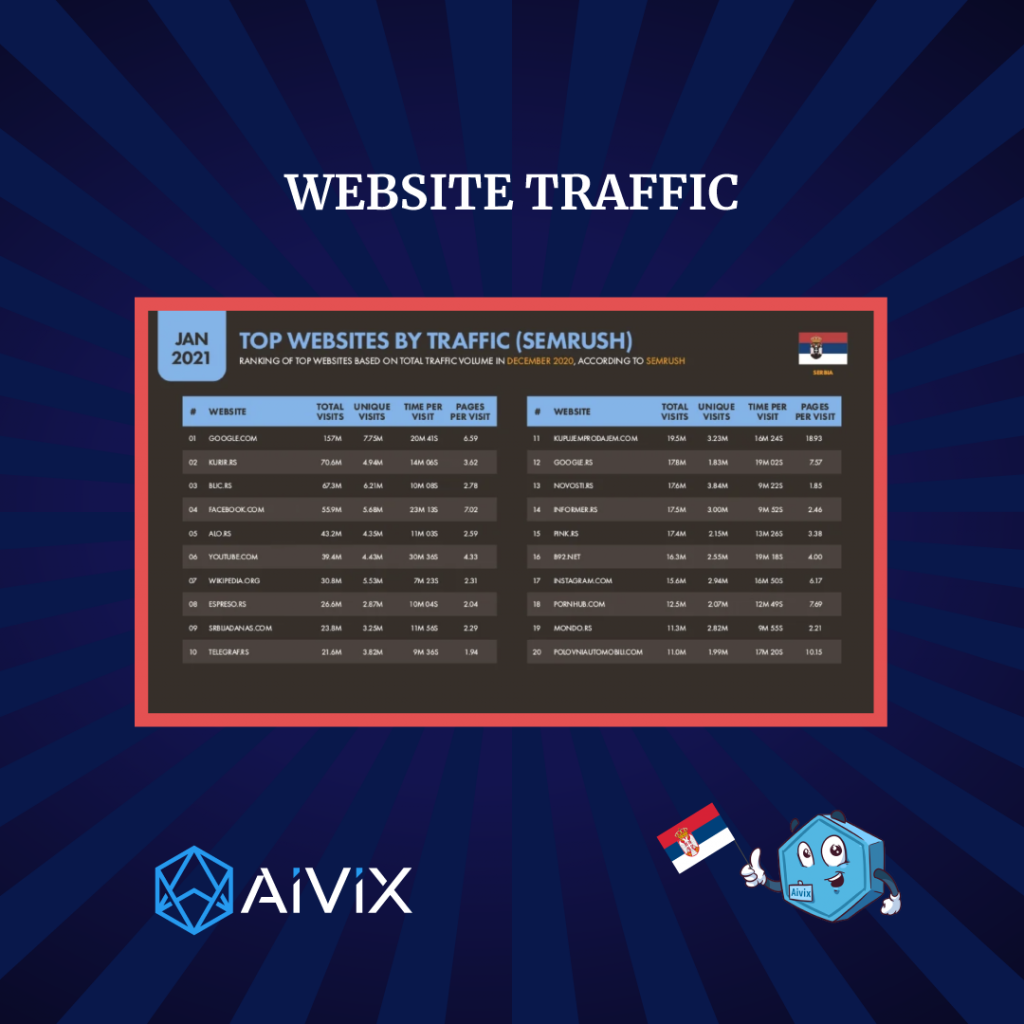
Working days and holidays
In Serbia, there are 104 weekends, 10 public holidays and 251 working days. There are working days from Monday to Friday in the week and weekends from Saturday to Sunday.
Non-working days and holidays in 2022:
January, 1-3 (sat-mon) – New Year’s Day
January, 7 (fri) – Julian Orthodox Christmas
February, 15-16 (tue-wed) – Serbian Statehood Day
April, 22-25 (fri-mon) – Orthodox Easter Holidays
May, 1-3 (sun-tue) – May Day
November, 11 (fri) – Armistice Day
Working Holidays in 2022:
January, 27 – St. Sava’s Day
April, 22 – National Holocaust Memorial Day
June, 28 – St. Vitus Day
October, 21- Memorial Day for Serbian victims of World War II
Serbian mentality
Friendliness: Serbs will give a chance to communicate and help if needed because they still know very well what it is to be in need.
Hospitality and generosity: Serbs will gladly share their home, time, and food with guests, like most Balkan nations.
Family values: Serbs believe in the family more than the average European, which again is a common trait in the Balkans. There, cousins are close siblings, and ethnicity matters as the first criterion for determining “who is who”.
No longer so religious: socialism has left its mark, and the attachment of Serbs to the Serbian Orthodox Church is often cultural and civilizational, much more than religious.
More conservative than the Western average: the traditional division of “roles” between the sexes still persists on the western side.

Advertising in Serbia
The advertising market in Serbia is actively developing. In 2020, just $64 million was spent on digital advertising in Serbia. By 2021, this market grew by 19.5%, putting Serbia in 3rd place in Europe. The advertising market has grown 6 times in a decade.
Advertising in social networks has also grown seriously by 33.8% and was worth 18.2 million dollars. Of these, as much as 16 million euros went to advertising on Facebook and Instagram. The share of other social networks is much smaller – we spent 89,000 euros on Snapchat, 890,000 euros on Linkedin, 518,000 on Twitter, and 459,000 euros on Viber.
Serbia has an Advertising Act (AA), which regulates various forms of commercial advertising, regardless of the medium used, including print, online and outdoor advertising. Certain advertising rules are also contained in Serbia’s Electronic Media Act (EMA).
Although the EMA applies to broadcasters of television and radio programs and not to webcasting on the Internet, it seems appropriate to apply EMA rules to online broadcasting as well (e.g., protecting minors from unsafe content).
Profile of the advertising consumer in Serbia
In recent years, Serbian consumers have gradually become price-sensitive as the 2008 crisis had a negative impact on purchasing power. Price remains the most important criterion when it comes to maintaining or changing buying habits.
According to a Nielsen survey, 77 percent of Serbian consumers rarely buy additional products, and mostly make do with the basics. In 2019, Serbian consumers spent an average of 22,977 dinars per month on food and non-alcoholic beverages (34.2% of total consumption) and 11,182 dinars on housing and utilities (16.7% of total consumption).
Serbian consumers increasingly choose online shopping (especially cross-border retailing at lower prices), which is expected to grow at an average annual growth rate of 5.59% until 2025. In 2021, 52.7% of Serbs shop online, and that percentage is expected to reach 61.4% in 2025.

Cryptocurrency in Serbia
In 2021, the “Law on Digital Assets” (LDA) came into force in Serbia. The law legalizes cryptocurrency trading and mining. The LDA also encourages cryptocurrency service providers to obtain licenses and permits from Serbian authorities to operate in the country.
The state bodies overseeing the cryptocurrency industry in Serbia are the Serbian Securities Commission (SSC) and the National Bank of Serbia (NBS).
Meanwhile, about 200,000 Serbs now own some form of cryptocurrency, and their number is actively growing. However, at the official level, the use of cryptocurrency for payments at the level of fiat currencies is still not defined. In terms of cryptocurrency adoption, Serbia has room to strive to catch up with regional leaders, the other two former Yugoslav republics.

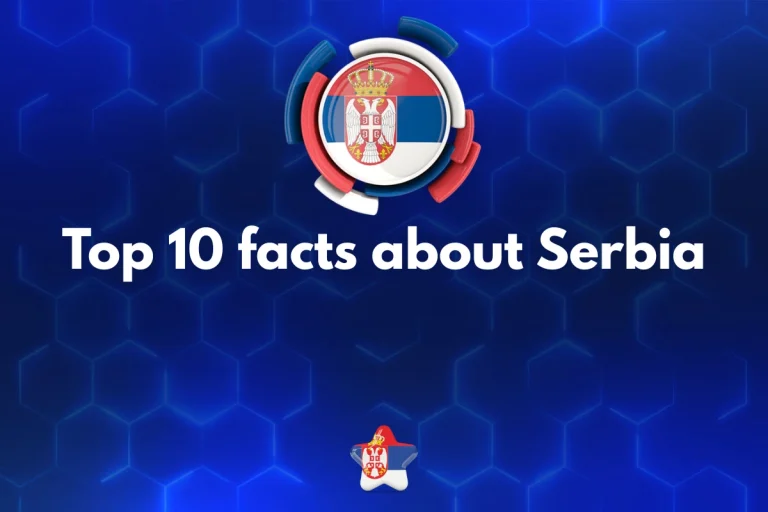
0 Comments